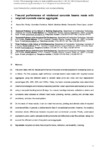Mostrar o rexistro simple do ítem
Flexural performance of reinforced concrete beams made with recycled concrete coarse aggregate
| dc.contributor.author | Seara Paz, Sindy | |
| dc.contributor.author | González-Fonteboa, Belén | |
| dc.contributor.author | Martínez-Abella, Fernando | |
| dc.contributor.author | Eiras López, Javier | |
| dc.date.accessioned | 2024-07-16T18:11:43Z | |
| dc.date.available | 2024-07-16T18:11:43Z | |
| dc.date.issued | 2018 | |
| dc.identifier.citation | Seara-Paz, S., González-Fonteboa, B., Martínez-Abella, F., Eiras-López, J. (2018). Flexural performance of reinforced concrete beams made with recycled concrete coarse aggregate. Engineering Structures, 156, 32-45. https://doi.org/10.1016/j.engstruct.2017.11.015 | es_ES |
| dc.identifier.uri | http://hdl.handle.net/2183/38091 | |
| dc.description | Versión aceptada de https://doi.org/10.1016/j.engstruct.2017.11.015 | es_ES |
| dc.description.abstract | [Abstract:] This work deals with the flexural performance of recycled concrete subjected to increasing loads up to failure. For this purpose, eight reinforced concrete beams were made with recycled coarse aggregates using two different water to cement ratios (0.50 and 0.65) and four replacement percentages (0%, 20%, 50% and 100%). Firstly, the basic concrete properties were determined (mechanical strengths and modulus of elasticity) and then, beam specimens were loaded up to failure using a four-point bending test at 28 days. As a result, bending moments, deflections, strains and curvatures were obtained at different load levels (cracking, service, yielding and ultimate state conditions), and also, the crack pattern. On the basis of these results, it can be noted that service, yielding and ultimate state of recycled concrete exhibits, in general, a similar trend to that of conventional concrete. However, the cracking behaviour shows differences between recycled and conventional concrete. Finally, code-based expressions were used to calculate bending moments and deflections under flexural load, taking into account the different content of recycled coarse aggregate. | es_ES |
| dc.description.sponsorship | The study is part of the projects entitled: CLEAM: Clean, efficient and nice construction along its life cycle” funded by the Centre for the Technology and Industrial Development (CDTI) and led by the Group of Economical Interest CLEAM-CENIT, AIE comprising by the country’s largest construction companies (Acciona, Dragados, Ferrovial, FCC, Isolux Corsán, OHL and Sacyr) and some PYME (Informática 68, Quilosa and Martínez Segovia y asociados). HORREO “Robust self-compacting recycled concretes: rheology in fresh state and mechanical properties (Ref: BIA2014-58063-R)” funded by MINECO. | es_ES |
| dc.language.iso | eng | es_ES |
| dc.publisher | Elsevier | es_ES |
| dc.relation | info:eu-repo/grantAgreement/MINECO/Plan Estatal de Investigación Científica y Técnica y de Innovación 2013-2016/BIA2014-58063-R/ES/HORMIGONES RECICLADOS AUTOCOMPACTANTES ROBUSTOS: REOLOGIA EN ESTADO FRESCO Y PROPIEDADES MECANICAS | es_ES |
| dc.relation.uri | https://doi.org/10.1016/j.engstruct.2017.11.015 | es_ES |
| dc.rights | Atribución-NoComercial-SinDerivadas 3.0 España | es_ES |
| dc.rights.uri | http://creativecommons.org/licenses/by-nc-nd/3.0/es/ | * |
| dc.subject | Recycled concrete | es_ES |
| dc.subject | Flexural performance | es_ES |
| dc.subject | Deflection | es_ES |
| dc.subject | Serviceability | es_ES |
| dc.subject | Cracking | es_ES |
| dc.title | Flexural performance of reinforced concrete beams made with recycled concrete coarse aggregate | es_ES |
| dc.type | info:eu-repo/semantics/article | es_ES |
| dc.rights.access | info:eu-repo/semantics/openAccess | es_ES |
| UDC.journalTitle | Engineering Structures | es_ES |
| UDC.volume | 156 | es_ES |
| UDC.startPage | 32 | es_ES |
| UDC.endPage | 45 | es_ES |
| dc.identifier.doi | 10.1016/j.engstruct.2017.11.015 |






